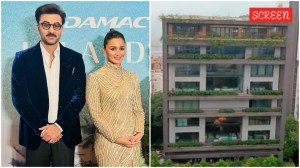Party on the house
AS the world discovered Goa in a riotous round of new year parties, Goa discovered itself. The year began with a quaint, residential area in...

AS the world discovered Goa in a riotous round of new year parties, Goa discovered itself. The year began with a quaint, residential area in Panaji —Fontainhas—getting a fresh coat of conservation. Its nineteen century homes are being painted bright and the streets swept clean. The neighbourhood is dressing up for a unique combination of art and heritage — the Fontainhas Festival of the Arts.
What makes this festival special is that it allows artists to display their works inside heritage homes. So besides art, visitors will get a peep into 100 year old Portuguese homes which are still lived in. Fontainhas is Panaji’s oldest district. Here many buildings have retained their traditional coat of ochre, pale yellow, green or blue. The other Portuguese section of the city, Sao Tome, lies to its north.
‘‘Thirty five homes in the Fontainhas precinct are participating in this festival. Here visitors are going to view and buy art, pottery and hand puppets made by local artists,’’ says Heta Pandit of the Goa Heritage Action Group. The non governmental organisation has initiated the festival, along with the Pune civic corporation, to revitalise the heritage of the Fontainhas area.
There’s more than art in the agenda of the week-long festival beginning January 10. There will be presentations by eminent personalities such as Jehangir Sabavala, Saryu Doshi, and Akbar Padamsee. In the evenings, there will be a mix of traditional and contemporary music, and dance performances. The streets will be lined with cafes and restaurants serving local cuisine. Streetside exhibitions and workshops by artists will invite the public to participate.
‘‘The nice thing about this event is the Latin ambience they create,’’ says Goa-based cartoonist Alexys Fernandes, who participated in the event last year. ‘‘Food and music on the wayside, it’s just like Europe.’’
Artist Tanya Mendonza feels this is a wonderful exposure for local artists. ‘‘In Goa, art is still pretty young in terms of commercialism, locals don’t really go to galleries. This setting is so much more intimate,’’ she says. ‘‘The house in which I had displayed my work last year had this 16th century altar and antique Portuguese furniture which practically made it a museum. Visitors were quite taken in,’’ she adds.
The Fontainhas precinct, also known as the Latin Quarter, was declared a conservation zone in 1974. Though it has been preserved to a great extent, some houses need restoration and repairs. The festival helps towards this end, since fifteen per cent of the proceeds from the sale of art works is given to the house owners. The arrangement is convenient. One room — usually the living room — is opened up for visitors from 10 am to 6 pm. So by the time the residents return from work, they have the house to themselves.
Though home owners initially had some reservations over opening their doors to strangers, they are now coming forward to co-operate.
‘‘It’s because of this festival that we are getting popularity,’’ says Damodar P. Agni, a 36 year old lawyer whose family has been living in the house for four generations. ‘‘If we don’t co-operate then it won’t be successful.’’
That the event has generated much interest can be seen from the fact that nearly 10,000 visitors attended it when it was launched in 2003. ‘‘People who are intimidated to go to art galleries openly turned out for this event and bought art,’’ says Pandit. ‘‘Besides, it allows for a lot of interaction between the artists and visitors.’’
This year Pandit expects the numbers to be higher. If you take into account the number of tourists already in Goa for new year celebrations, that shouldn’t be too difficult.





- 01
- 02
- 03
- 04
- 05


























